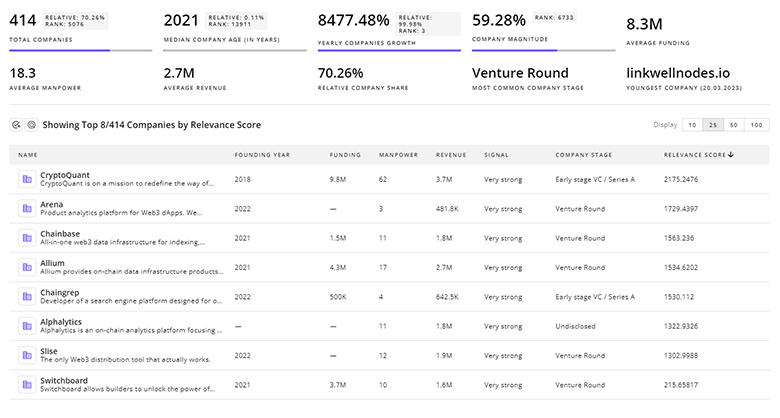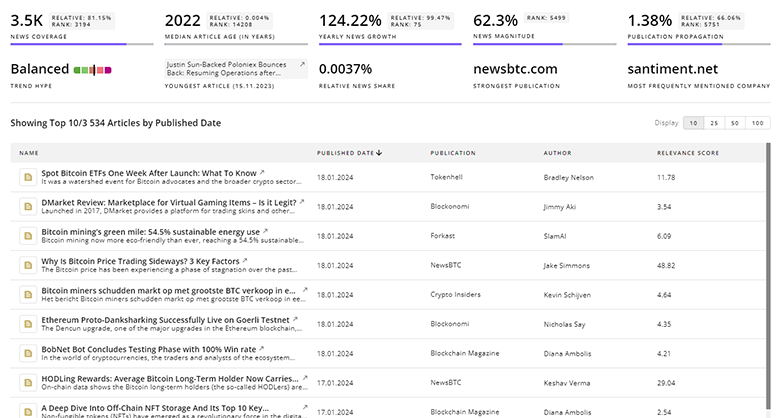
Photonic Chips Report
: Analysis on the Market, Trends, and TechnologiesThe photonic chips market is accelerating: the internal photonic-chips trend report records a 25.8% CAGR for silicon photonics, placing the segment on a steep growth path supported by a 2022 base market of US$1.76 billion and a projected US$7.14 billion by 2029, which signals large near-term commercial opportunity in data-center and telecom interconnects. Market forecasts from independent sources corroborate strong expansion—examples include a 2025 market estimate of US$3.87 billion for photonic chips and a broader PIC market forecast of US$13.9 billion (2024) to US$24.2 billion (2029)—all driven by AI traffic, co-packaged optics, and material innovations (silicon-nitride and thin-film lithium niobate) that enable higher bandwidth at lower power Global Photonic Integrated Circuits Market Growth Analysis.
The last time we updated this report was 11 days ago. If there’s something missing or off, your tips are welcome!
Topic Dominance Index of Photonic Chips
The Dominance Index for Photonic Chips merges timelines of published articles, newly founded companies, and global search data to provide a comprehensive perspective into the topic.
Key Activities and Applications
- High-speed data-center optical interconnects for AI and cloud infrastructure — replacing copper links with 400G+ silicon-photonics transceivers and co-packaged optics to reduce power per bit and latency; this is the largest near-term revenue engine.
- Co-packaged optics (CPO) and chiplet optical I/O — integrating optical I/O next to ASICs to bypass board-level bottlenecks and scale GPU/accelerator fabrics for training and inference workloads.
- Quantum photonic infrastructure — PICs for routing, multiplexing and on-chip sources/detectors that support quantum key distribution and photonic quantum processors; low-loss SiN and TFLN platforms are primary enablers.
- LiDAR, sensing and spectroscopy on a chip — compact, mass-producible PICs for automotive and industrial sensing, including on-chip spectrometers and hyperspectral sensors for real-time analysis Photonic Chip (Optical Chip) 2025-2033 Overview.
- Photonic accelerators and neuromorphic/optical processors — optical matrix-multiply engines and all-optical cores aimed at energy-efficient AI inference and specialized optimization tasks.
Emergent Trends and Core Insights
- Material stack diversification alters product segmentation and margins. Silicon retains scale advantages but thin-film lithium niobate (TFLN) and silicon-nitride (SiN) now capture premium use cases (high-speed modulators, ultra-low loss passive circuits, quantum photonics), creating differentiated product tiers and new foundry demand Photonic Integrated Circuit Market Size, Trends Report 2025-2030.
So what: suppliers that offer multi-material PDKs or foundry flows will command higher ASPs and strategic partnerships with system OEMs. - Co-packaging and heterogeneous integration are shifting system architecture. Recent commercial moves toward CPO and ASIC-photonics integration indicate buyers prefer integrated modules rather than discrete optical components PICs market could top $50BN by 2035.
So what: EMS and system integrators will capture more value; component vendors must move up the stack to avoid commoditization. - AI-specific photonics segment grows faster than base PIC market (analyst estimates ~19% CAGR for AI photonic chips), making photonic accelerators an attractive niche for VC and strategic capex Photonic Chips For AI Market Analysis, Size, and Forecast 2025-2029.
So what: firms with demonstrable AI benchmarks and software toolchains gain premium multiples; system adoption hinges on integration into existing ML stacks. - Foundry and packaging scale become gating factors. Growth will favor companies that de-risk wafer supply, wafer-level lasers, and automated PIC packaging/testing flows.
So what: investors and corporate buyers should prioritize partners with PDKs, short prototyping lead times, and demonstrated volume yields. - Regional dynamics: North America leads in revenue today while Asia-Pacific posts the fastest growth; policy and telecom capex in APAC drive foundry and subsystem demand.
So what: market entry strategies must account for APAC manufacturing scale and North American system integrator partnerships.
Technologies and Methodologies
- Silicon photonics (SiPh) — CMOS-compatible platform for high-volume transceivers and modulators; benefits: foundry scale, cost leverage; limitations: on-chip light source challenges that push heterogeneous integration OpenLight.
- Thin-film lithium niobate (TFLN) — high-performance electro-optic modulators and programmable circuits for telecom and AI interconnects; enabling lower insertion loss and high linearity Lightium.
- Silicon nitride (SiN) — ultra-low loss passive waveguides used for large interferometric circuits and quantum photonics where photon lifetime matters New Origin.
- Heterogeneous integration and wafer-scale micro-transfer printing — combine III-V active components with Si/SiN passive platforms to deliver integrated laser + PIC assemblies INSPIRE platform Photonic Integrated Circuit Market, by Component Type.
- Photonic packaging, photonic wire bonding, automated active alignment and PDKs — process innovations that materially reduce assembly cost and improve yield; these are becoming table stakes for commercialization Photonic Integrated Circuit Market Size & Share Report, 2030.
- Superconducting nanowire single-photon detectors (SNSPDs) and integrated SNSPD-PIC stacks — crucial for high-sensitivity quantum links and advanced LiDAR/sensing Pixel Photonics Photon Technology Italy SRL, PHOTEC.
- Inverse design and AI-assisted photonic design — inverse topology and machine learning accelerate compact, high-efficiency component designs and shorten iteration cycles Ultra-Compact Inverse-Designed Integrated Photonic Matrix Compute Core.
Photonic Chips Funding
A total of 199 Photonic Chips companies have received funding.
Overall, Photonic Chips companies have raised $29.0B.
Companies within the Photonic Chips domain have secured capital from 908 funding rounds.
The chart shows the funding trendline of Photonic Chips companies over the last 5 years
Photonic Chips Companies
- Xscape Photonics Inc — early-stage venture company developing photonic platforms targeted at scalable, energy-efficient AI/ML hardware. The firm emphasizes high-bandwidth PIC solutions intended to lower operating cost for AI data centers; Series A funding and product roadmap target datacenter interconnect and accelerator I/O.
- Ephos — glass-based PIC foundry and developer focused on glass waveguide circuits and 3D integration for classical and quantum devices. Ephos positions itself as a manufacturing partner for companies needing low-loss glass platforms and rapid prototyping to move from lab demos to productized PICs.
- QC82 — a small team pursuing room-temperature photonic quantum computing through low-loss photonic designs and room-temperature photodetection breakthroughs. QC82 targets scalable quantum nodes that reduce cryogenic complexity, which would materially cut deployment cost for quantum services if achieved.
- Rapid Photonics — foundry and process innovator for CMOS-compatible lithium niobate and barium titanate PICs with fast turnaround and cost focus; their DEpicT® waveguide approach aims to shorten prototyping cycles for LN-enabled modulators and quantum components.
- SNOChip — specialist in on-chip diffractive optics and metasurfaces for imaging and illumination integration; SNOChip develops metalens and hologram optics suited for compact LiDAR, sensing and camera modules where optical pre-processing saves system complexity.
Delve into the corporate landscape of Photonic Chips with TrendFeedr’s Companies tool

438 Photonic Chips Companies
Discover Photonic Chips Companies, their Funding, Manpower, Revenues, Stages, and much more
Photonic Chips Investors
TrendFeedr’s Investors tool provides insights into 1.1K Photonic Chips investors for you to keep ahead of the curve. This resource is critical for analyzing investment activities, funding trends, and market potential within the Photonic Chips industry.

1.1K Photonic Chips Investors
Discover Photonic Chips Investors, Funding Rounds, Invested Amounts, and Funding Growth
Photonic Chips News
TrendFeedr’s News feature offers you access to 1.6K articles on Photonic Chips. Stay informed about the latest trends, technologies, and market shifts to enhance your strategic planning and decision-making.

1.6K Photonic Chips News Articles
Discover Latest Photonic Chips Articles, News Magnitude, Publication Propagation, Yearly Growth, and Strongest Publications
Executive Summary
Photonic chips now occupy a clear, investable intersection of material innovation, systems integration, and application demand. Near term, value concentrates in two linked vectors: (1) data-center and AI interconnects that require CPO and silicon-photonic scale, and (2) speciality PICs (TFLN, SiN, InP) that deliver high-performance modulators, quantum links, and sensing modules. Commercial winners will combine credible manufacturing scale (foundry or proprietary PDK), demonstrated integration with electronic ASICs or system stacks, and a clear path to reduce packaging and test costs. Strategic priorities for industry players and investors are to secure wafer-level supply, validate system-level benchmarks for AI and quantum use cases, and form supply partnerships that align materials and packaging capabilities with customers’ integration roadmaps.
Are you an insider in the trends or tech industry? We’d love for you to contribute to our content.












